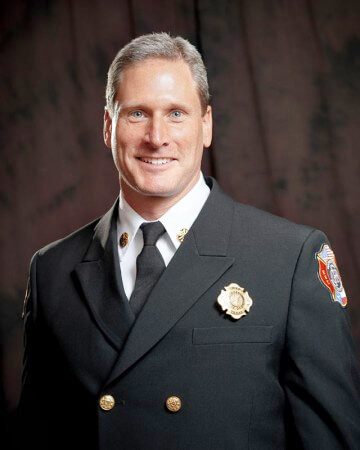Faced with a wildfire that started near Lake Georgetown and quickly spread west, Georgetown and Liberty Hill fire departments worked together to fight the blaze that consumed 445 acres in July during one of the driest seasons Williamson County has seen in years. And they weren’t alone—22 other agencies joined forces with the two city responders in the statewide effort.

Absolutely, without a doubt, this has been one of the driest seasons we’ve had in the last 10 years.”
Georgetown Fire Chief John Sullivan
The San Gabriel fire originated on the south side of the lake off Tower Road and took firefighters five days to extinguish due to the large area, rough terrain, and heavy vegetation. Fire departments from Leander, Round Rock, Jarrell, Cedar Park, and Hutto joined the effort, as well as area police departments, Williamson County’s sheriff’s office and EMS, Texas Parks and Wildlife, and U.S. Fish and Wildlife. “We were very fortunate with the support that came in on that fire,” Georgetown Fire Chief John Sullivan says. “Liberty Hill was where it originated, but fire knows no geographic boundaries. It doesn’t stop at the city border. It’s important to work collaboratively and collectively, because it outpaces and outscales the resources any one department has.”
WILDFIRE PREVENTION
Dry and windy conditions combined with everyday activities like backyard barbecues, burn pits, and spark-enhancing metal work are breeding grounds for wildfires, Chief Sullivan says. The San Gabriel fire was caused by sparks from a resident doing metal work, so he urges caution when it comes to these types of activities. “It sounds overly simple, but be aware that things are dry and be conscious of things that are hot or have the potential to cause sparks.”
Residents can take the following precautions to reduce the risk of wildfires:
Be a responsible driver: While it’s never a good time to litter, it’s especially important to avoid right now. “It’s especially horrible right now when people are discarding cigarettes on the highway. They think it’s not a big deal, but it’s precisely why we’re responding to grass fires on the freeway,” Chief Sullivan says. Drivers should also be aware of potential fire hazards created by vehicle problems. “It can happen innocently—a blown or flat tire and somebody has to pull off to the side of the road. They’ve got a hot vehicle and the grass is high. The way to mitigate a possible fire is to be hyper vigilant about your car being hot enough to cause sparks.”
Maintain your home: Maintaining vegetation around one’s home is key to reducing the risk of wildfires. “The taller the grass is, the bigger the fire gets and farther it can travel,” Chief Sullivan says. In addition to keeping lawns mowed and trees and bushes trimmed, homeowners should reduce vegetation and backyard debris near their homes. “If you’re barbecuing in the backyard, the grass can catch fire, and if you have debris in your backyard like wood logs or a burn pit—that can catch fire, then you find your house on fire. People underestimate how quickly a fire can spread.”
Don’t burn outdoors: In June, Williamson County commissioners issued a 90-day burn ban. The ban prohibits burning combustible material outside of an enclosure; yard waste such as leaves, grass, brush, and other yard trimmings, or burning to clear land of trees, stumps, shrubbery, and other vegetation. The order urges caution when it comes to outdoor welding, cutting, or grinding, including ensuring the metal work area is free of vegetation, notifying the local fire department of planned metal work, having a fire extinguisher nearby, and inviting another person to be on the lookout for sparks that could cause a fire.
Websites with information on what to do regarding wildfires:
Scan the code to visit CalFire Ready for Wildfires, which share information about creating defensible space zones around your house.
Firewise USA (NFPA.org) has more tips on reducing wildfire risks and how other Georgetown communities can join Sun City as a Firewise site.
